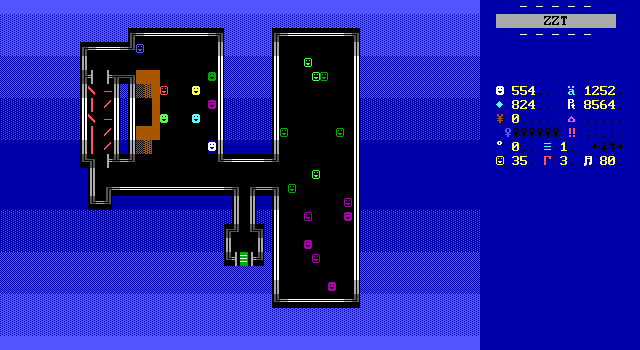
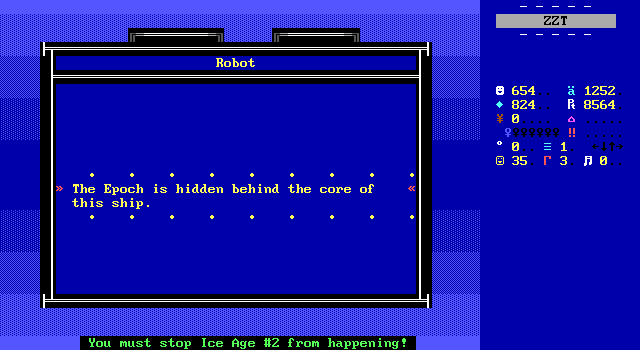
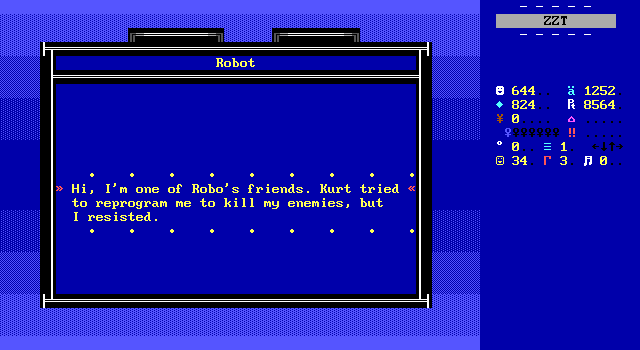
In fact, most of the occupants are robots. We were told that Kurt's been using them as slave labor, but this is the first encounter with any since entering the fortress area. They're all happy to help and it's not clear what Kurt's doing to maintain control over them seeing as how they've even managed to prevent being reprogrammed. It could be a cool thing to have this aspect explored a little more. Charlie doesn't get to do anything directly to free the slaves or run into any moral quandaries about killing reprogrammed robots in self-defense. They're just chilling at this bar.
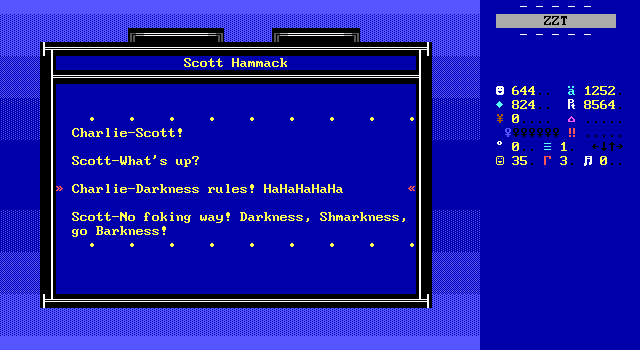
But whenever there's a bar in a ZZT game, there's a good chance you'll find cameos of ZZTers/MZXers of the era who are also probably too young to be served alcohol. They'll also be sure to drop ZZT and MegaZeux community catchphrases like "Darkness Schmarkness go to Barkness" (which also comes up if you pick "Darkness" as a wrong answer to one of the riddles back in Palm Tree).
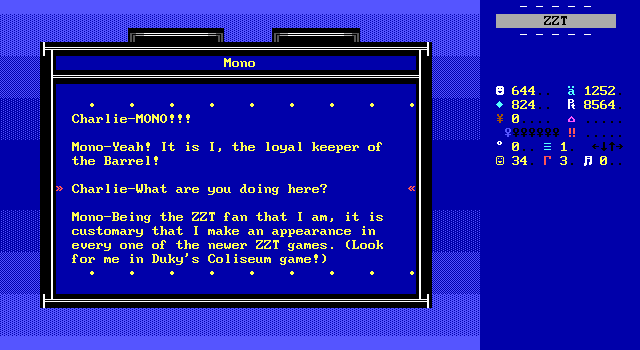
For a second cameo we have Mono who was responsible for running a popular ZZT archive known as the "Big Bustin' Barrel of ZZT games" assuming my memory serves correctly.
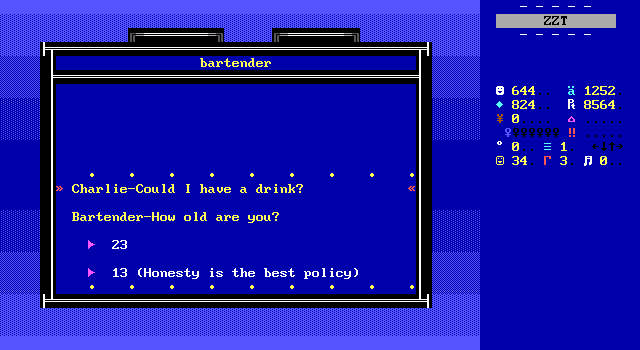
And there's the confirmation of Charlie's age. The text file describes him as a young adolescent and fits is nicely with the young teenager who has to save the world trope popularity in ZZT games of the mid-90s.
Fair.
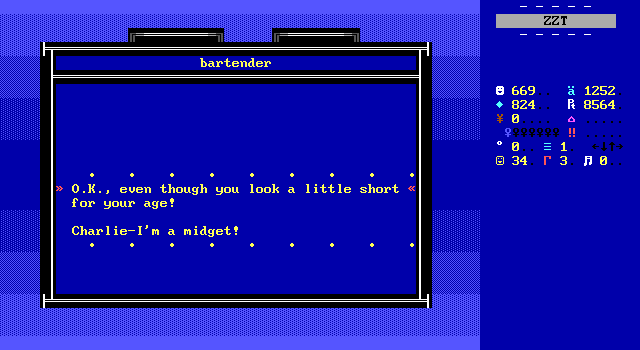
Fooled that guy.
Overflow is actually one of the rare ZZT games that lets the underaged character drink and straight up rewards them for doing so. The drink is free and restores 25 health. After serving a minor a drink the bartender disappears forever so don't expect a source of infinite health.
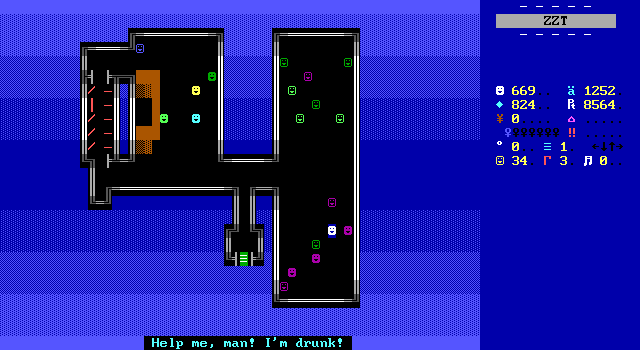
There's a stronger portrayal of alcohol as a negative in the dance area where some of the drunks (trust me, they all are) will call for help. They cannot be helped. They can only dance endlessly in silence.
And that's all for the bar! It feels more like it should be a hidden area but it's accessed just like any other room. The only thing "secret" about it is finding the right path in the mess of passages below.
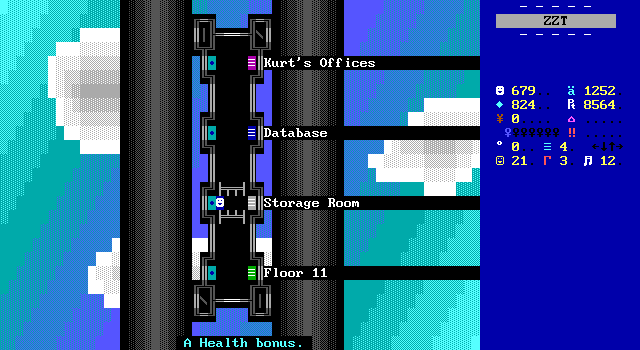
But now it's time to actually start checking out this elevator and getting some keys. Going in order has served me well enough throughout the game so no sense stopping now.

The storage is devoid of people and robots and instead full of crates and a large computer in the center of the room.

Charlie can try and use the computer but the only thing that happens is "JON". There was a Jon way back on Native's Isle that Charlie could argue about Doom and RPGs with so I suspect this is meant to be referencing that same character. There's no functionality here though making it feel like a non-sequitur.
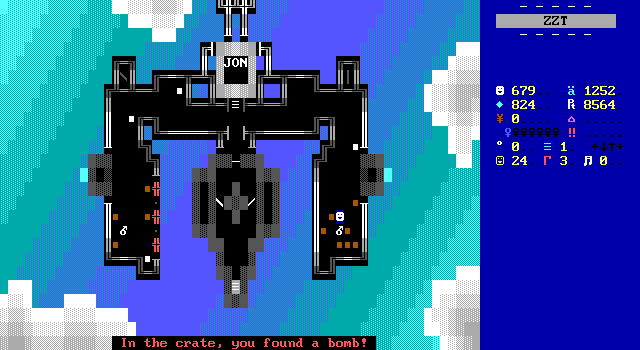
For the rest of the room there are nothing but white crates that can't be moved, and brown crates that are just boulders to push around. Some of the white crates have bombs inside which can be used to blow up the unusual walls that break from the linewall pattern that's pretty much everywhere else.
Touching the odd walls will cause Charlie to comment on how they look weak and they do stand out enough once you reveal a bomb anyway since the breakable wall character is going to be the only thing you'd expect to be able to destroy, but if you actively try it is possible to move the bomb away from the way and soft-lock the game. The bomb on the right doesn't even need to be pushed to hit the wall.
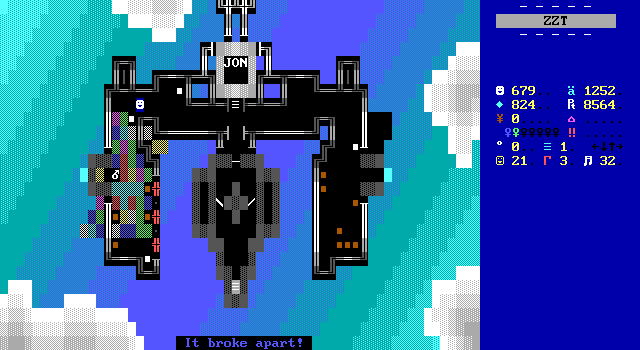
The one on the left is a little more difficult to reach as there are some blinkwalls in the way, but the boulder boxes can block them off.
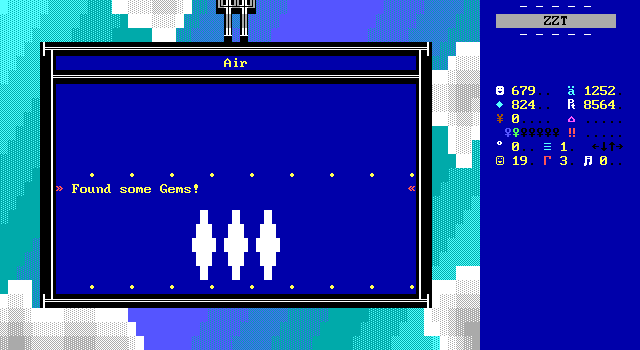
This other way contains a hidden cache of gems and ammo if it's touched a second time. This is all just optional and you only get three gems which are actually placed onto the board. This is only notable because at this point there's no way to go back and spend any gems so the three health you get is the only actual benefit here.
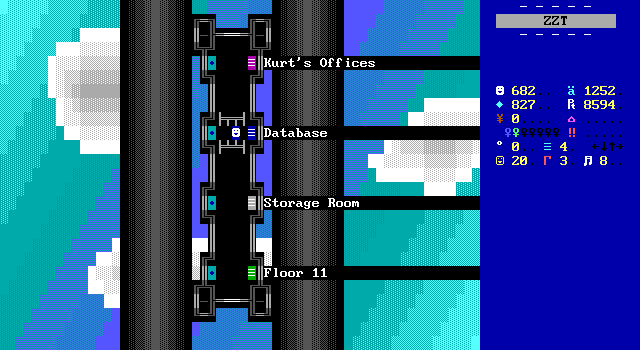
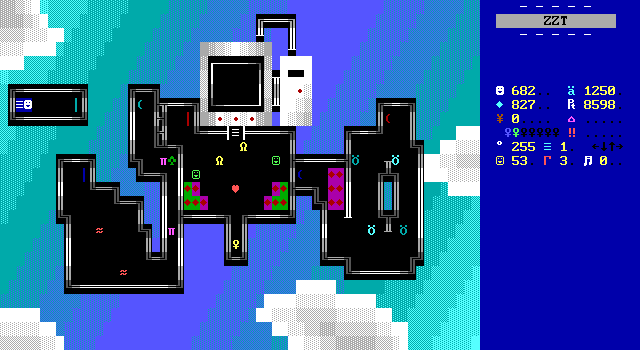
Curious use of transporters here. The very first set could just connect, but there's a commitment to the theme of this board being disjointed.
More creatures, more computers, but also more people who are no more concerned with the lions in their room as the beach-goers on Treasure Isle.

In reality, this is another cameo, but rather than being of a specific person these green fellows are "Alien Gaurds" from Code Red. The homage is explained to the player and a salute is given to Janson for her work in ZZT and MZX. Afterwards Charlie is free is to pick up the yellow key and play with the computer a bit.
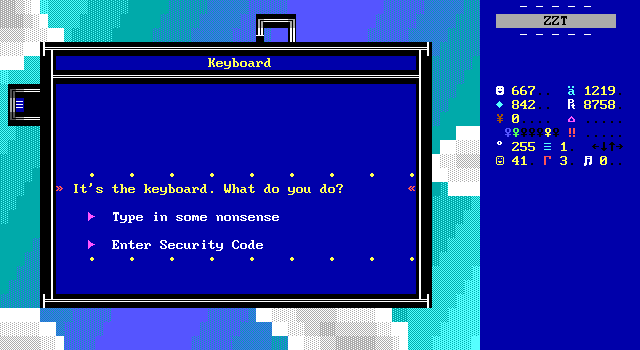
Unlike the one in storage, there's a little more to be done here.

Keymashing reveals Overflow's Day of Lavos equivalent in keeping with its Chrono Trigger origins. I don't know if there's any significance to the March 12th, 1996 date or not.
Chrono Trigger happened to debut on March 11th, 1995 in Japan. An earlier version of Overflow is dated Oct. 31st, 1996 though this is still labeled as the 2.0 version so there's a possibility that this is the day the original game was released. Whether or not it would be a different date in the original release is impossible to say until a copy is found so right now everything is just speculation really.
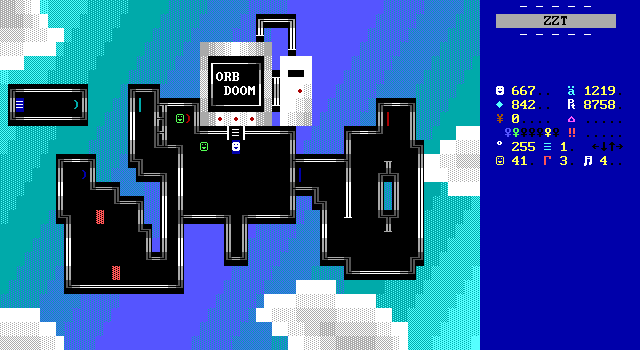
In addition to learning when Doomsday was the option also causes the phrase "ORB DOOM" to appear on screen. Achalon is described as having started as weird hedgehog creature so this might be might as a hint of something grander being responsible for Achalon and more, or that little hedgehog arrived in an orb or curled up in a ball or who knows.
The other option is to enter a security code, but right now Charlie doesn't have it. It is structured like the phone booth though in that you can blindly type digits. Just good luck getting anything out of a five digit password combination.


Any hopes of getting to finally confront Kurt are quickly dashed, but on the bright side we're finally getting a unique background again. It's not as good as a lot of previous ones, ad we've certainly seen a nicer sunset back at Nick's funeral, but I'll take it. I think it might work a little better if the larger landmass on the left wasn't extending all the way to the horizon since a sense of distance isn't really conveyed when the coastline is the same scale towards the front as the back like that.
This isn't the time to admire and/or criticize the view though. Charlie's still in need of one more key and also this office is guarded by centipedes that start awfully close to the door.
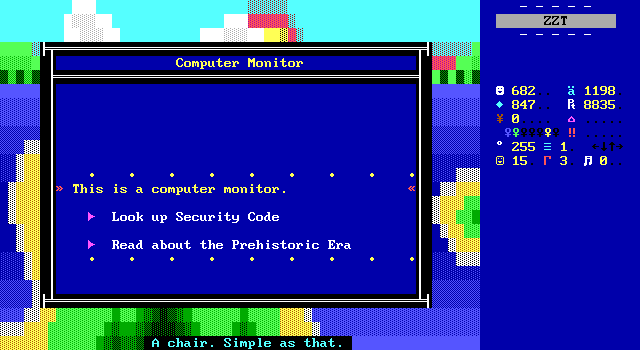
Kurt's personal computer offers some very convenient options.

Well. That's the code to the computer in the database room. I never would have guessed.

I wasn't expecting information about prehistoric times to be written in the future tense. It's also far more specific and very much in the territory of blatant sequel foreshadowing.
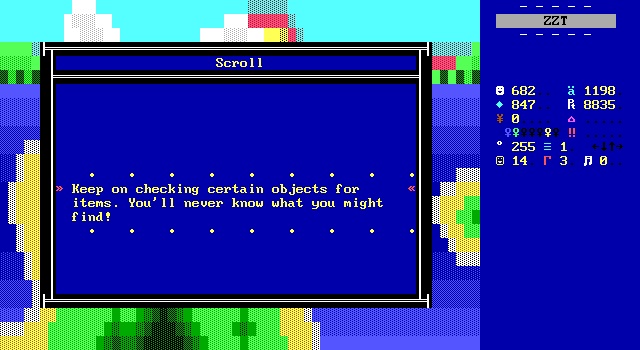
The scroll opposite Kurt's desk I think is meant to hint at the secret gems in the storage room that give ammo for checking again? I appreciate the hint although that ammo is so utterly not needed at this point. Still, it's better than having something mandatory be hidden away in an obtuse manner like that.
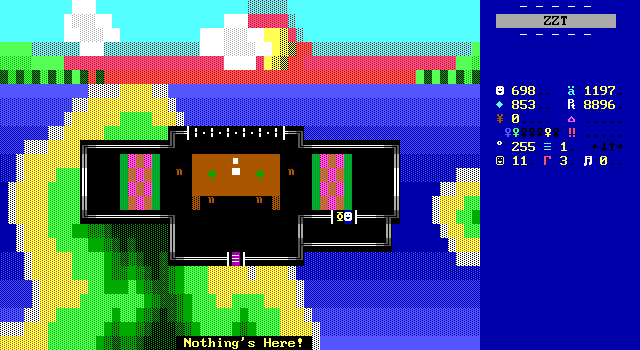
Two other scrolls are identical about this odd closet that appears to be empty. Of course, with a hint like this you know there has to be something to it. It's in fact full of invisible gems.
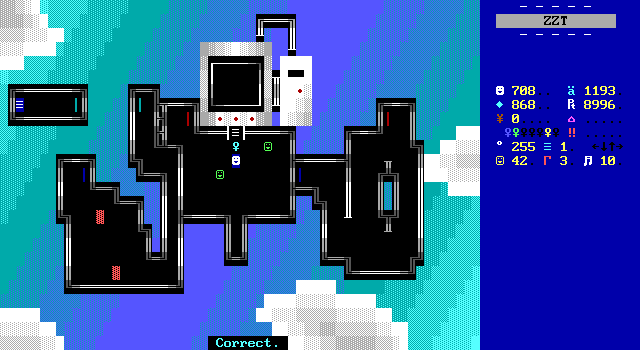
With Kurt's impossible to guess password of "12345" in hand Charlie can zip back down to the database and enter the security code which just results in a cyan key being spit out.
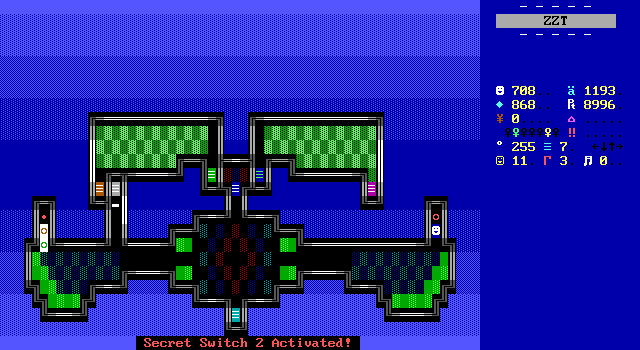
All these keys and doors amount to just moving forward as it's the only way to do so. At no point does Drelick give an explanation for any of this. There's no "Kurt's hiding in this hidden area and you need the four keys" or anything like that. Charlie just does all this because it's all he can do.
As far as the gameplay goes this is fine, but it does feel like some opportunities are being squandered to flesh out this world more. Consider that we still don't know what these pirates really even do? Kurt shot Nick for insulting him, but it's been stated that the pirates have been a threat to this world for some time. A little exploration of that would be welcome.
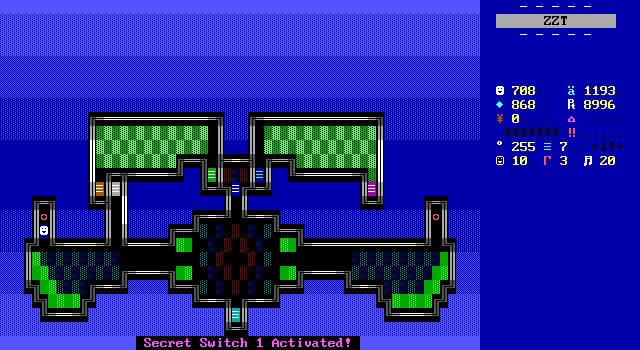
The final switch opens up one last door that will indeed lead to Captain Kurt.
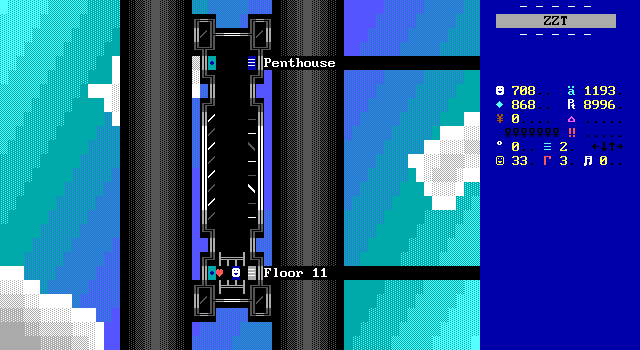
Via yet another elevator. I like that we actually get to see a second home of Kurt's. The first is on board the fortress so yeah, why wouldn't he have a nicer place in his actual base of operations?

Well, it's bigger at least. It still doesn't look all that impressive to me. I'm not a fan of the red and blue checkered carpet either. Yikes.
Some flashing text and arrows really really want to draw the player's attention to a monster filled room that makes up the right half of the board so that seems like a good place to start.
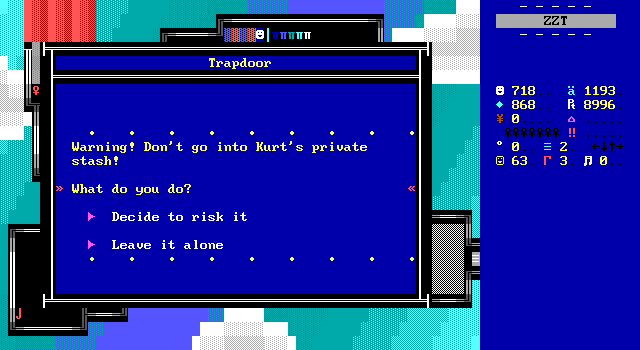
At the same time the door provides a warning to keep out. Obviously Charlie is going in.
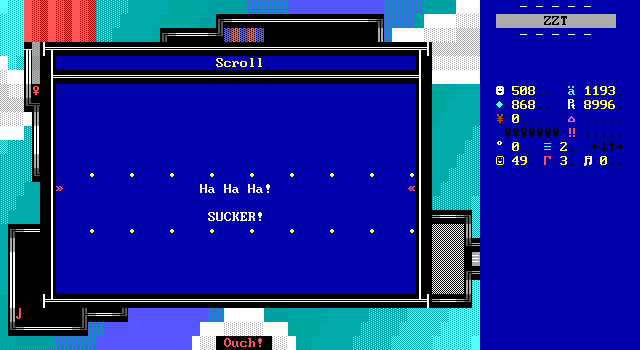
Thanks to some extremely aggressive tigers actually reaching the end cost me more than 200 health! And the stash is empty. Not even any invisible gems it exists entirely to trick the player.
Thanks to the overly generous accumulation of resources throughout the game though, I didn't even feel a need to reload my save to undo my actions. I'll own it.
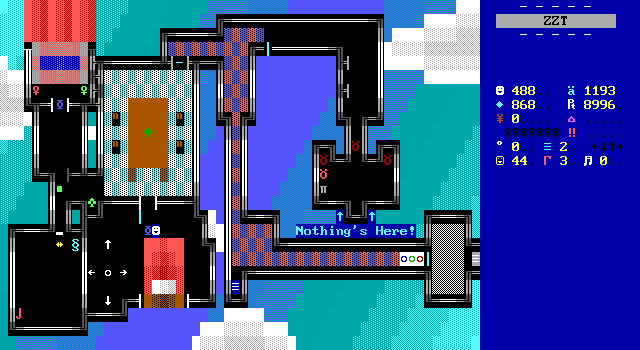
I'm at the bedroom.
I'm at the robotic crane operation control room.
I'm at the combination bedroom and robotic crane operational control room.
In this puzzle, you need to hit the
buttons to move the crane. The big center
button will shoot. You will only get one
shot! To win, kill the Beast 'o Blue, and
move the Sliders out of the way. Your
reward will be the two keys located in
the spa. If you get shot, you'll need to
pay.
Finally the hundreds of gems pay off. Despite being a "crane" this is no mere UFO catcher, it's a combat arena, and a clunky one at that. Charlie has to hit the arrows to line up a shot with the cyan beast without getting shot. If the crane is hit or fires and misses, 25 gems are needed to go again.
The beast moves slowly enough that it's not very difficult to hit, but all this feels like busywork. It takes a few attempts, but with more than 800 gems to spare, even the high cost of firing provides no real obstacle here.
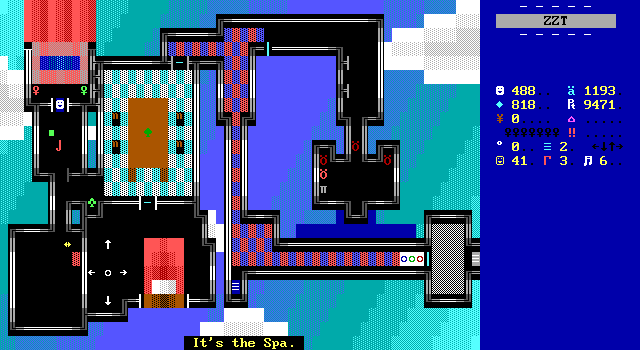
Once the beast is killed the crane still needs to be operated to push a boulder out of the way in a real awkward design choice. Instead of making the player push this slow moving crane along, just get rid of the boulder once the beast is shot! This does nothing but slow things down and potentially break the game if the player just holds up and accidentally pushes the boulder into the doorway to the spa with the keys although with the slow speed of the crane I can't really imagine this happening in practice.

There's still one problem though. The spa only provides two keys, and a third blue one is needed to continue on.
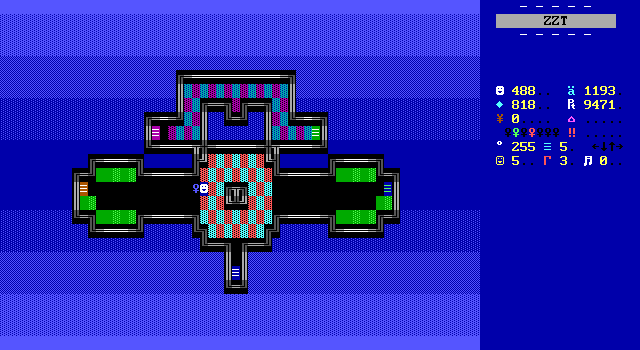
This board had two blue keys on it and while it did give me an opportunity to pick up the second key on another pass through the board I left it suspecting it was two keys just to provide symmetry. I figured it was more likely to cause problems by picking it up than actually being needed for several boards later.
Also navigating back down to this point was a nightmare of passages.

Upon touching the final door the screen is erased to black leaving the player in an empty void save for the passage forward. It's an interesting effect since it so strongly relies on the player to keep things moving. You can hang out here in "The Mu" for as much as you like. I suspect this game (at least its original release) predates using player clones and passages to trigger a warp automatically being common knowledge so asking the player to politely walk into the passage isn't a tall order.
Admittedly, without this effect in place the player would have already been planning to enter that same passage.
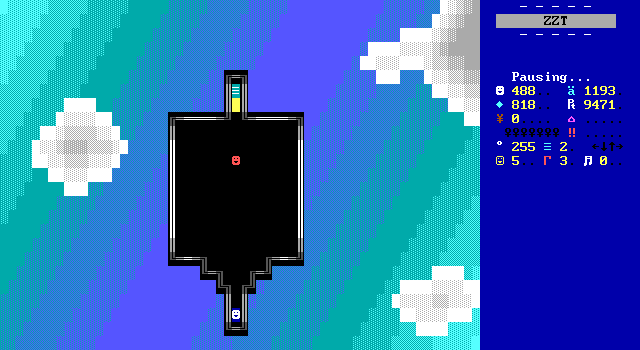
Finally, on a plain-old sky background, Charlie comes face-to-face with Captain Kurt. What's this confrontation going be like?
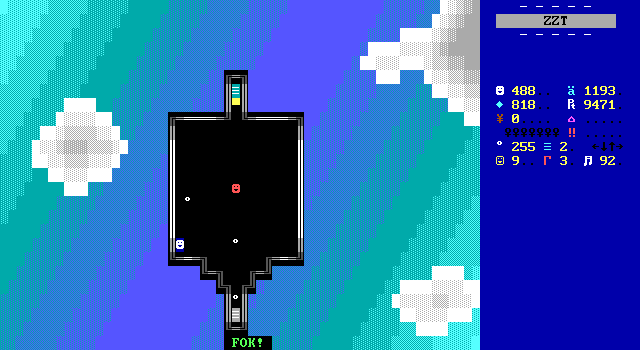
Well, Kurt drops a slanted F-bomb and begins running around the room firing wildly in the player's direction.
I mean, nothing about the previous boss or enemy design would really have you expected anything else. The fight's fair although Kurt definitely takes things to another level in terms of his speed and aggression. It's a pretty dull fight though, and the lack of any dialog beyond the the letters here makes it very lacking in impact.
I know Drelick didn't do a whole lot to get the player to care about avenging Nick's death, but Charlie at least seemed to have some connection with him. This should be dramatic even if the fight itself is exactly like any other ZZT action game. The characters just get no real development, or even much of an identity in the first place to put any weight in this scene. Kurt is treated no differently than the Cocoa-Bombers or weird mechs from earlier.
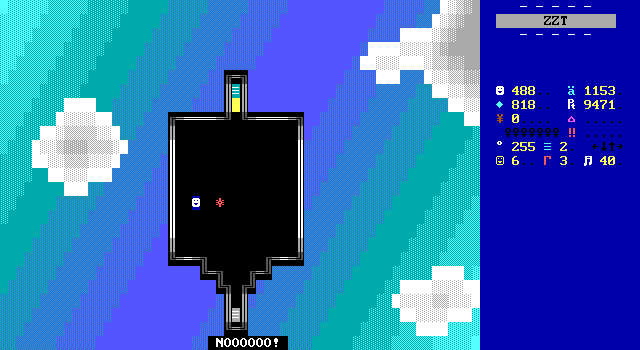
Seven shots is all it takes to do him in where he lets out a scream of defeat before dissolving away. I didn't even get hit. The force field that blocks the exit vanishes and Charlie can claim his time machine.
Also you can go back to the void since there's still a passage here and no attempt made at keeping the player out of it.
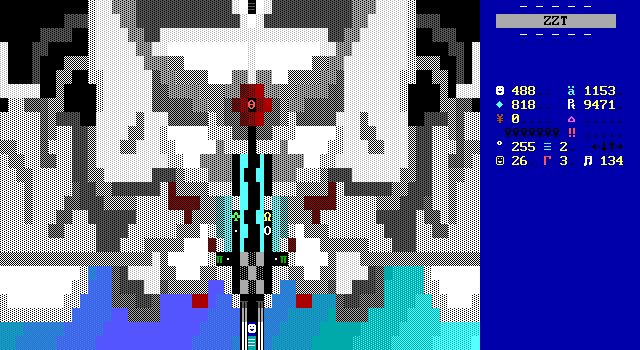
File this one under another instance of looking cool but not quite comprehending what I'm looking at. I think Charlie is boarding a big mech or something? Or it's an overhead view of a ship? I do not know.
I also do not know why there are duplicators with enemies at this point. Charlie won. Let him have this.
What is definitely nice about this board is the weird cyan... beam things that animate in and out giving this sort of crackling energy look to them as Charlie heads into the core.
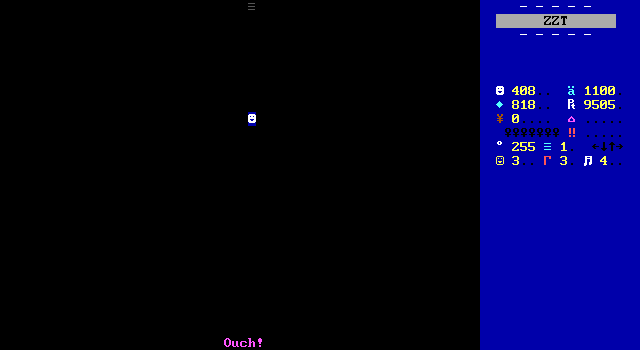
Which itself needs to be shot a bunch of times before Charlie can get past it, so you will be shooting backwards at the enemies that slowly manage to get into the beams. After a few hits everything again is erased to black which feels a bit more appropriate this time as the core has just been shattered so why shouldn't some radical event happen?
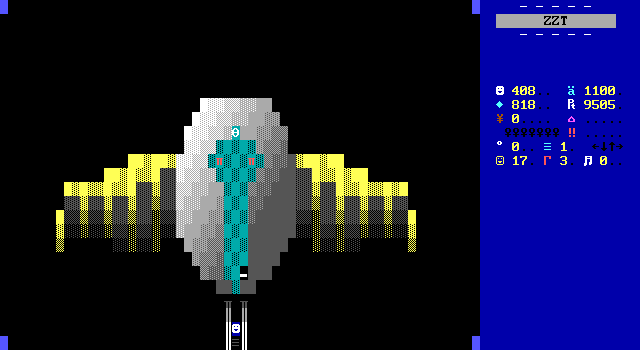
Welcome to the Epoch.
It is not the prettiest ship, but it does travel through time and that's more important than the aesthetics. Though others might argue that if you're going to build a time machine into a ship, why not do it with some style?
At the controls, there's only one thing to do.
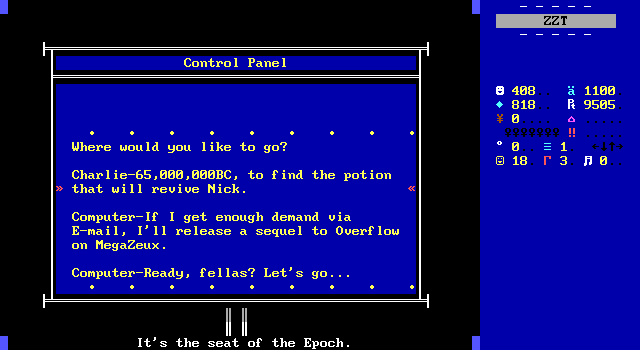
What?
There was a computer like 10 minutes earlier that had information about prehistoric times, why didn't it mention this potion? Why did it mention bronze spears instead?
Drelick possesses the computer to gauge interest in a sequel for MegaZeux. No such sequel exists MZX, ZZT, or otherwise.
Honestly though? I kind of wish one did.
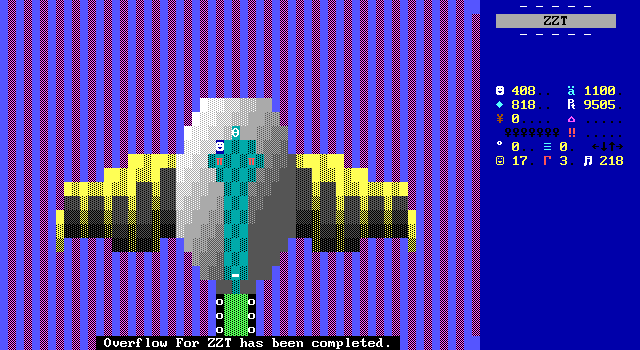
The Epoch blasts off through time and the quest continues.
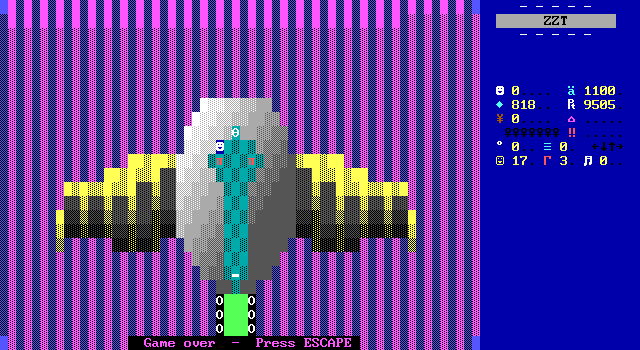
All that for a cliffhanger. Not that there was any surprise there. This is a game about obtaining a time machine to be able to defeat Achalon. It was pretty clearly not going to wrap it nicely, though the focus on Nick is definitely more of a surprise.
But we made it. One hundred and one boards of ZZT game. The world is still a wreck in this time zone, but hopefully with Captain Kurt gone things will be a lot better for the people who live there.
For Real Final Thoughts
Oh, I adored Overflow. There is no mistaking it, this is absolutely a classic. I'm surprised it never showed up on my radar before.
The game does have a Classic Game of the Month award from 2000, and a rather late review from 2008 by Rob P. that praises it quite a bit. I tried searching through some more of the era ZZT magazine worlds and could only find two mentions of it. Firstly Futureware 2 which has very little in the way of content, but does give it a 97% score in graphics. Second, Futureware 3 where it's name-dropped in an interview with Jeff Conroy (who... wrote both magazines actually) where it's listed as one of his favorite games. Hey me too dude.
When covering these long forgotten games for Worlds of ZZT, it's always a great feeling to come across a wonderful game that I haven't played before. I've played more than my share of well known classics, but it's games like this that demonstrate to me the importance of this work. Overflow has a well respected author's name attached to it, but seems to have fallen by the wayside not long after its release. When z2 first got its review system implemented, users flocked to the classics to give them the 5 out of 5 ratings they deserved. Nobody came back to Overflow and it's an absolute shame.
From start to finish Drelick is constantly impressing the player with these backgrounds unlike anything I've seen before. Even excluding Nick's funeral scene, Smuggler's Shanty is quite possibly the most visually distinct location I've seen in a ZZT game. Overflow isn't a game that's just about looking pretty though. Drelick repeatedly manages to make the most of what ZZT offers with its numerous dungeon sequences filled with intolerant zoo animals. The all too common sprinkling of creatures in ZZT action games without the slightest thought of what fighting them will be like is what led to the late 90s rejection of these enemies in the first place. Drelick demonstrates here just how capable these assets can actually be. Fights never feel unmanageable, ammo and health is provided in abundance, and the player's job as Charlie is simply to blast their way through in a laid-back tropical environment.
In modern times games tend to be played specifically to be completed, and it's easy to forget the earlier days when more demanding games (sometimes too demanding), more freedom to play for the sake of play, and just being bad at video games at a young age meant that finishing any game felt like a huge accomplishment. Overflow's non-linear structure would absolutely have been a boon to the audience of today playing it 20+ years ago. Nowadays the non-linear aspect doesn't have as much of an impact. The areas, while they do vary from each other, never really get too wild from the others, but I can imagine somebody who struggles with the action genre loving the opportunity to see that much more of the game in multiple play-throughs even if they never finish them.
Today that non-linearity still offers up the benefit of being able to balance not the difficulty of the game but of its highs and lows. I keep coming back to Smuggler's Shanty for a reason, and if the game was nothing but "My friend Nick was shot by pirates so I'm going to climb this tower and beat them up" I think it would be a winner with that area of the game alone. Overflow shines so brightly because its level design is willing to throw out any sense of being in a realistic structure and focus entirely on providing a fun room for the player to fight through. Its weakest moment by far is when it's most tethered to geography with Treasure Isle's forced 3x3 grid layout. I don't think there's a bad way to play through this adventure, but some paths may result in the game dragging itself down for longer periods of time than are necessary. You'd probably best enjoy things sandwiching Treasure Isle in between Palm Tree and Smuggler's Shanty. Native's Isle isn't anything special, and the Ruins provides some comic relief in the bizarreness of the segment, but those two don't make the game stand out like PT/SS or fall flat like TI.
Again this game is 100 boards long, and just the fact that it can hold your interest for that long should tell you what kind of quality we're dealing with. At some point I had the epiphany that while Overflow says it's Chrono Trigger with the serial numbers filed off, perhaps a more apt comparison would actually be towards Rotaj J. Russel's Link's Adventure trilogy. Both games are heavily focused on completing these dungeons full of built-in creatures. Link's Adventure has been a favorite of mine since I was a child, and I still love it dearly to this day yet it's really hard to defend that love to those who didn't grow up with it. That game features plenty of empty boards with rectangles of lions and boss fights with the strategy of holding down fire for so long that the stars in the way disappear. It turns out that when I play Link's Adventure, the game that I'm playing in my head with all the nostalgia filters on is Overflow. Overflow does what Link's Adventure is doing but in a way that you can earnestly recommend to others. The action is designed, the locations are diverse, and the environments are beautiful.
Overflow's 1997 release date paints it as a swansong to the classic ZZT adventure that defines the earliest days of ZZT. It's got just as much Town in its DNA as it does Link. Multiple paths to collect five key(card)s each with mix of action and puzzle. It definitely skews more action, but if you were asking the pioneers of ZZT's earliest years what a ZZT game from 1997 would look and feel like, it would undoubtedly be Overflow. The rejection of ZZT's bestiary in the years following is a misunderstanding of what those creatures mean. The idea that a cluster of tigers was amateurish but a cluster of objects that acted similarly but shot each other constantly is a false belief that the misuse of these elements necessitates their exclusion rather than attempting to learn how to use them properly. It's the equivalent of games whose yellow borders are replaced with blue borders. The issue isn't the color choice, it's the lack of understanding of what having a border means when a board is set in space among a starry background. ZZT games filled with objects that just loop #go rnd #shoot seek betray that the lesson that was learned wasn't the correct one.
Overflow offers the opportunity to actually see what's possible with ZZT when you stop for a moment and think about how to enhance the experience. Its objects and its detailed backgrounds serve to enhance the player's experience in a way that the "standard" approach of objects and say the Interactive Fantasies boulder blend (not to pick on it as the only such style) simply can't because they're focused more on making life easier for the programmer rather than the player. That thoughtfulness for people playing ZZT is catching on more now, but to see it 20 years before Benco's Ana makes me wonder what could have been.
I think I've gushed enough here so I need to try and come up with some complaints. The obvious is of course that Treasure Isle is an utter flop compared to the rest of the game that plays to none of Overflow's strengths. The object based enemies Drelick includes function and mostly avoid the friendly-fire syndrome that plagues most other action games that use them, but there are dozens of them and the player never gets to really understand how they behave. They offer up variety but you won't finish this game and be able to tell the difference between 90% of them from one another. The game's bosses are also a joke, basically just giving regular object-based foes a few hit points and maybe setting the cycle to one.
The story exists as window dressing at best and the characters have no development. Except for Nick who goes from alive to dead. The original plan for an absurd 10 chapter game was scrapped but enough remains of it in place to squander the plot. Charlie seems to be very familiar with a lot of these characters. (Although I thought he was flung through time to get here?) The player however is not, and Drelick doesn't provide anything to get the player to make the connections to the other characters that Charlie already has before the game even starts. Very rarely does one expect anything out of ZZT writing, but an attempt isn't even made in this case. Some kind of narration or inner monologue or something to provide a connection to these characters would have been very welcome. Instead we prank call them and argue about RPGs while quoting Ghostbusters.
Lastly, it is still pretty long. I loved this game, but it did not need to max out ZZT's board limit. I suspect that during development Drelick saw himself approaching that limit and did it to be able to say that he made a game as large as it could be. Internally the fortress segment begins with the entrance, then immediately goes to Captain Kurt's fight, the reactor, the Epoch, and the cameo bar. Drelick gets what he needs to include to create a finished segment and throw a nod to Mono and Scott. Afterwards all the floors of the fortress are created with board #100 being the sound test. In a post Code Red world, making a game as massive as possible absolutely would have been a bullet point for promoting the game, but today it feels like the game is stretched a little more than it should be. The sudden reliance of plain blue backgrounds towards the end are evidence to me of wanting to just be done with it.
Probably the biggest instance of "why is this even here" comes from the alternate ending path which were it just a fight with Achalon and then celebrating a victory would count for something, yet somehow it has to extend itself into the warring kingdoms of Salkin and Dalkin. The Achalon fight is fine (if comically easy) and the giant space bug background shows that Drelick's abilities with these backgrounds goes beyond the Margaritaville environments of the flooded world. The "fight the final boss early" serves as a Chrono Trigger reference that for some reason keeps going.
But these complaints are just a few drops in an ocean of a flooded future Earth. Luke Drelick's Overflow is straight-up one of the best ZZT worlds I've ever played and I regret that I didn't do so twenty-something years ago. I'm extremely thankful that Hydra recognized it in 2000 so that it already shows up as a featured world on the Museum because this is absolutely a must-play. This game does so much right that other ZZT games of this era got wrong that it's startling to me that it wasn't held up as a pinnacle of the action genre in its own time.
BONUS: When you play a good ZZT game released in the mid 90s:

With love to the MegaZeux community~

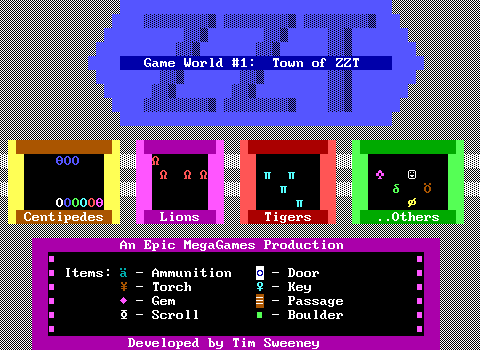


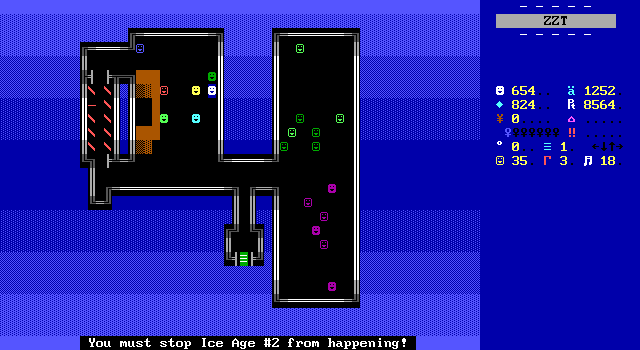

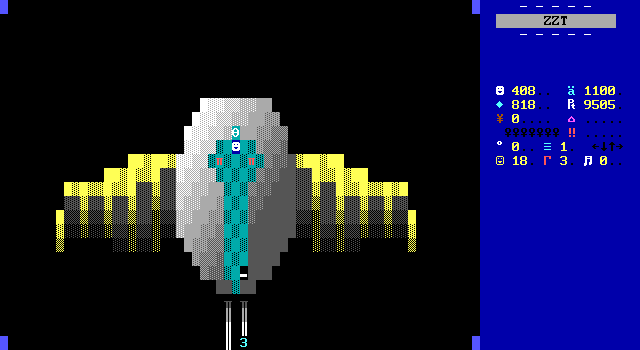

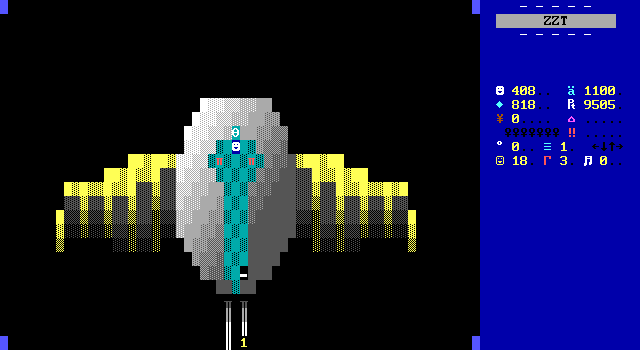
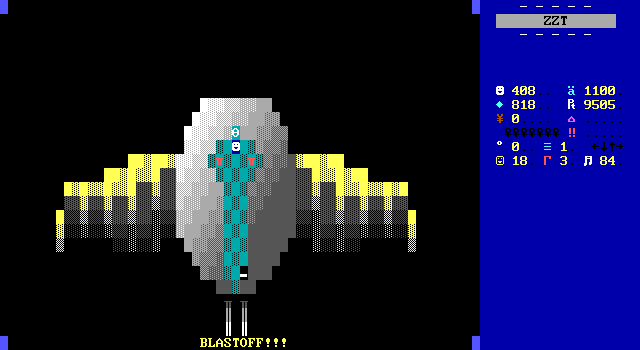
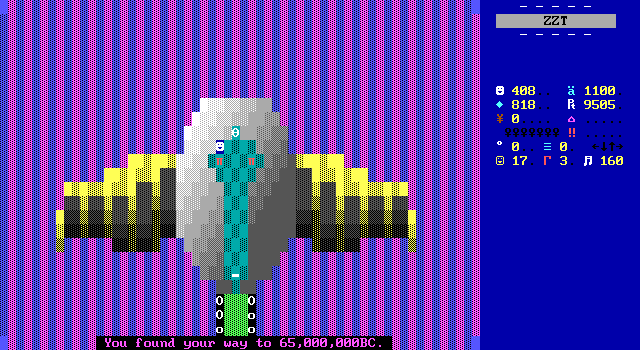

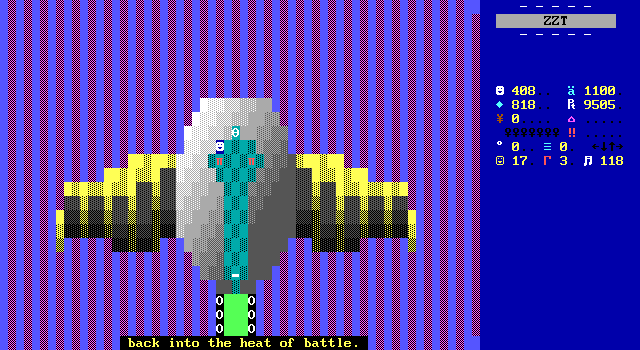
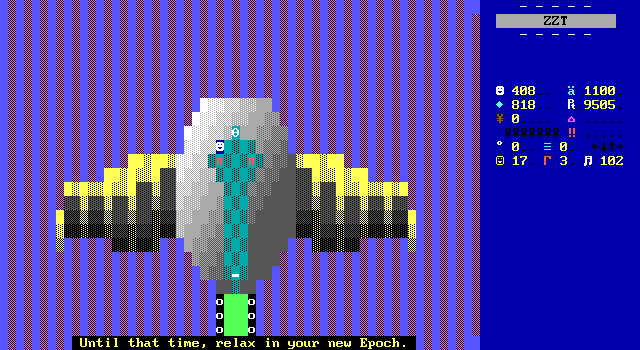
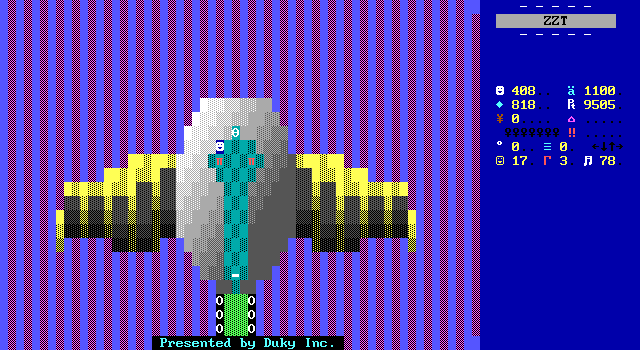
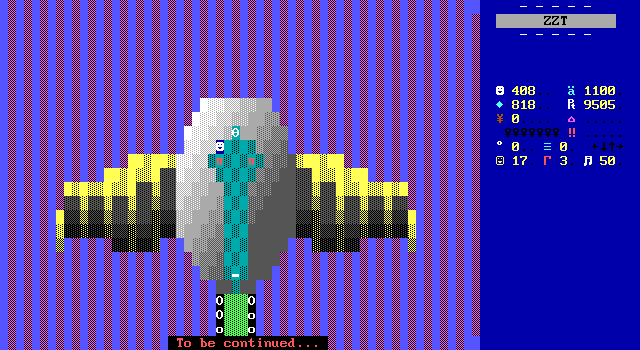
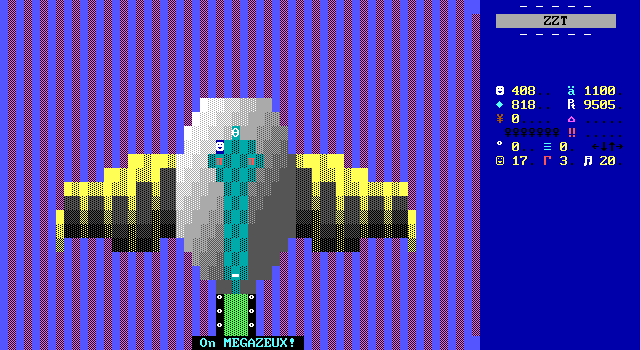

...to a packed bar?
And we're not talking Kurt's band of dangerous pirates. Nobody here will hurt Charlie. The scroll warns you not to drink too much (how old is Charlie again?)